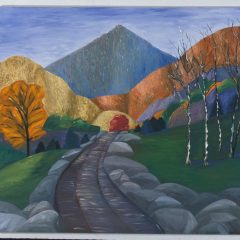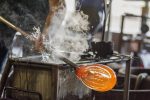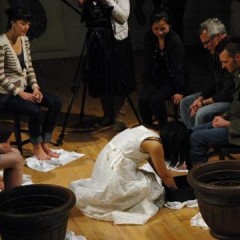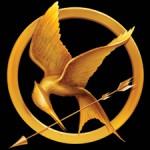There’s something about Havana. Most likely, we have never been; and yet images easily come to mind — public domino matches, old VWs, Che stencils and people dancing to Buena Vista Social Club — making us feel as though we already know it. We often forget the country’s struggle and immense poverty, instead believing in this land’s creativity, relaxed lifestyle, and spirit of revolution.
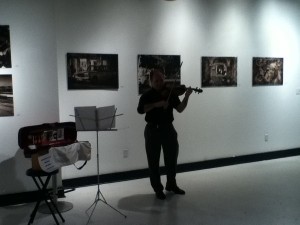
Three photographers at Dalet Gallery in Olde City captured these imaginations and much more, revealing Havana’s nuances, hidden corners, and shy grins. The exhibition, Havana: Piercing the Darkness, opened First Friday, December 7, with a violinist moving visitors along through the gallery space.

Ilya Genin’s photographic collages carry the rust, grittiness, and beauty of Havana’s architecture. Layering portraits on top of portraits and flags atop stairwells, the collages evoke a busying energy, empowered by the texture of their arrangement. Havana becomes a multi-layered space, compact and tight, where music and dancing seem to follow you everywhere.
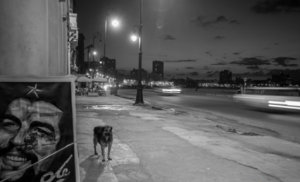
Genin’s most successful images, however, are her non-collaged, black and white photographs of Havana at night. “On Malecon,” 2011, catches a composition with a poster of Che, a stray dog, curved streetlights, and an outdoor café – the icons exhibiting a historical narrative of Cuban identity.
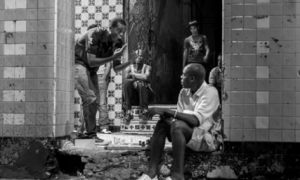
“Fair Game” and “Extreme Chess,” 2012, the first showing two boys playing soccer on a rooftop at night and the latter capturing an intense moment of conversation during a presumably intense moment in a game of chess, bring movement to an otherwise quiet darkness, energy and passion captured through stillness.
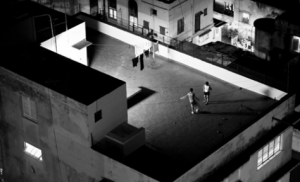
Susan Bank’s photographs get to the heart of community in beautiful compositions of angularity and directness. She captures wrinkled hands meeting rippled water and a robust laugh so unobtrusively, her subtlety as delicate as the haiku verses she references. A standout is “Hotel Roosevelt,” 2012, where Bank captures light, architecture, and dreaming in another subtle historical narrative, peeling paint and open windows alluring onlookers.
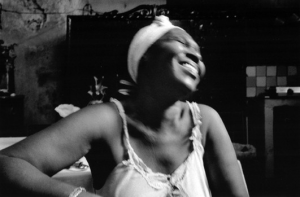
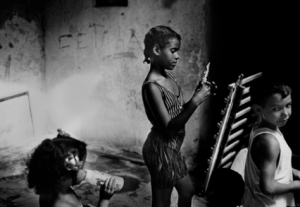
Many of her images have a sacred and folkloric quality, such as “White Feather,” summing up images of Santeria or perhaps merely chicken soup. The placement of the photographs within the gallery space creates lovely stories that speak both independently and in longer narratives. For instance, stray dogs, which are such a staple on Latin American streets that they become largely ignored, are represented in her photograph, “Resignation Dogs.”

The gangly pack of strays is equally intimidating, vulgar, and sad. This photograph is placed beside Limbo, an image of young people on an old stairwell, seemingly waiting. In both photographs, this combination of intimidation and sadness makes you cautious about catching a direct eye, although — through a lens or on paper — you inevitably will.
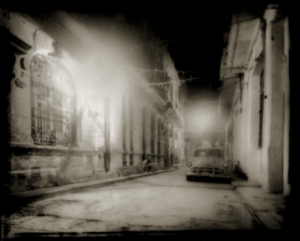
Ron Tarver’s photographs are true to his artist statement: “Floating on an outdated dream … an attempt to reveal what is beneath the contradiction … a sense of poetry and wonder.” His images have an archaic feel with spectacular contrasts of light and dark, shadows becoming moving actors in Havana’s story.
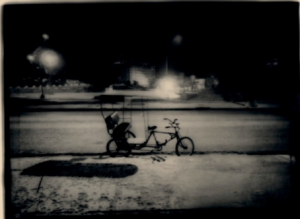
“Reynaldo’s Bicycle” carries a grand sense of width, the black curves conjuring up images of Amelia Peláez’s classic paintings – wrought iron reflected in the bicycle’s shadows. The photograph’s emptiness, a common motif in many of his exhibited works, carries a transfixing fragility, the images becoming declarative statements in their delicateness.
“Avocado Street,” with two huge bursts of light exposure, has a cinematographic quality. The imagery is so archaic looking you cannot help but think hard about Havana’s contemporary society and landscape. “Domino Players” is another highlight, seriousness captured in studied faces. The photograph speaks to all three photographers’ ability to project subtle moments of Cuban identity and culture in still, yet energy-filled, images.
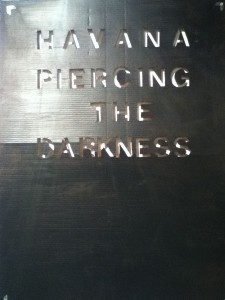
While he’s not in this show, another photographer who could have easily fit in with these three is local artist Laurence Salzmann. In 2010, he photographed young boxing students in Santiago de Cuba, producing a stunning book with Cuban artist, Luis el Estudiante, entitled, La Lucha. Without any of the expected images of Che and domino matches, Salzmann’s photographs offer a different portrayal of Cuban life.
The entire exhibition is illuminating and brings that flicker of light to the otherwise unseen happenings of Havana life. None of the context is too new, yet the photographs are still fresh and present new sights into established perceptions. That old familiar-yet-so-unfamiliar feeling of Cuba certainly takes over the gallery.
Havana: Piercing the Darkness is on view until January 19, 2013 at the Dalet Gallery, 141 N. 2nd Street in Olde City.


